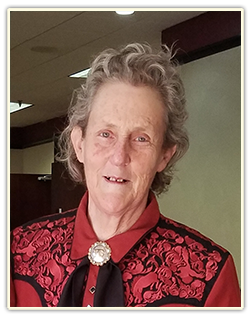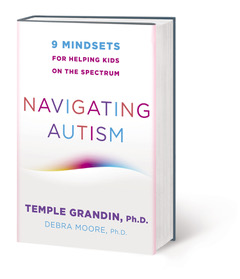
ASK TEMPLE!
Click "Ask Temple" to submit a question and it will be sent to Temple! She will answer as many as she can.
Webinars & Conferences
Upcoming Conferences
July 29 - Aurora, CO
August 14 - Hershey, PA
August 18 - Webinar
August 20 - New Orleans, LA
August 23 - Attica, MI
September 10 - Dallas Forth Worth
September 11 - Knoxville, TN
September 15 - Missoula, MT
September 19 - Cincinnati, OH
November 19 - Memphis, TN
November 20 - Jonesboro, AR
Temple's Latest Books!
A MUST LISTEN!!
Temple Grandin earns Dole Leadership Prize!
NAVIGATING AUTISM
"The Outdoor Scientist"
Reducing Noise Oversensitivity
Some individuals with autism or sensory processing disorder are so overly sensitive to noise they can not tolerate noisy places. Sometimes over sensitivity can be desensitized when the child can control the noise. Children have learned to tolerate noisy devices such as vacuum cleaners, hair dryers or tolls if they were able to shut the noise on and off themselves. One mother let her child play with the vacuum cleaner and he went from fearing it to loving it. Another success story was a boy who hated the buzzer on the scoreboard in the gym. When the gym was empty they let the child press the buzzer button. When he could control the noise he figured out he could perform rhythms with it. Wearing head phones all the time may make sound sensitivity worse. To give the child control he/she can have the headphones with them so they are there if needed. The child should be urged to try and not wear them.
What does sensory diet mean?
A sensory diet simply means that at certain intervals, a child may need a break to calm his nervous system down. Sensory problems are on a continuum from mild to severe. Children with more severe sensory problems will need more frequent breaks to calm down an over aroused nervous system. During these breaks, the child can engage in sensory activities that are calming. It is often best to have the breaks at scheduled times to prevent accidentally rewarding a child for throwing a tantrum. If the child gets sensory breaks after he/she behaves badly, he/she may behave badly to obtain more breaks.
What are the most common sensory therapies?
- Deep pressure such as rolling up in mats, weighted vest, squeeze machine or weighted blanket to help sleep.
- Slow swinging 10 to 12 times a minute for calming
- Brushing the skin with soft brushes for calming (Wilbarger Method)
- Irlen lenses and pastel-colored paper to help with reading. Pale colored lenses help a subset of children with autism or dyslexia with reading. When the child picks the right pale color that works for them, the print will stop jiggling on the page. Often pale pink, light blue or light tan sunglasses are helpful. More information is on the Irlen website. Try printing reading materials on different pastel papers such as light green, light blue, tan, gray, lavender, and light yellow. The child must choose the paper that works best for them. Children who respond well to colored lenses and colored paper often cannot tolerate 50- or 60-cycle florescent lights. If possible, get the child away from florescent lights. They can see the flicker of florescent lights and they make the room flicker like a strobe light.
- Chewing Activities – Some children respond well to having things to chew. Chewing activities will calm them down. They need oral stimulation.
- Balls and other items to hold in their hand and squeeze. This helps some kids sit still.
- Auditory Training – There are a number of CDs and devices for auditory training. The child listens to music that has been electronically modified. For some children, auditory training may help reduce sound sensitivity and improve the ability to hear hard consonant sounds. Some auditory training programs are very expensive and the results are highly variable and may not be worth the cost. Try simpler methods first such as speaking slowly to the child to help him hear hard consonant sounds. Singing is helpful for some children and they may be able to learn to sing words before they can learn to speak them. Singing coupled with careful enunciation of hard consonants, such as the “c” and “t” in cat may be helpful.
How is sensory integration determined to meet the needs of the individual?
When a sensory therapy works, the child will usually want to do it. Therapies that work should show a beneficial effect on behavior. In some cases, sensory therapies can help reduce or stop self-abusive behaviors. When this works, the child will start to hit himself, but will stop because normal pain sensation returns.
What are the goals of sensory therapy?
To help reduce tantrums, meltdowns, and hyperactivity, increase staying on task, and reduce self-injurious behavior.
How soon will improvements start?
Often improvements will occur within a few weeks. When a sensory therapy works, there will be less meltdowns, tantrums, and more calm behavior. The child will be able to stay on task for longer periods of time.
Stumbling Blocks For The Autistic
If algebra had been a required course for college graduation in 1967, there would be no Temple Grandin. At least, no Temple Grandin as the world knows her today: professor, inventor, best-selling author and rock star in the seemingly divergent fields of animal science and autism education.
"I probably would have been a handyman, fixing toilets at some apartment building somewhere," said Grandin, 66. "I can't do algebra. It makes no sense. Why does algebra have to be the gateway to all the other mathematics?"
Temple Grandin Interview with Rick Kleffel
Beyond reading ‘The Autistic Brain,’ I knew that there was some sort of preparation I should do before I talked to author Temple Grandin. Watch the HBO movie, I was told. I could have gone to YouTube and looked her up. I decided to meet her first in person, and let the conversation play out as it would.
Temple Grandin is an imposing and intense presence, who immediately asked me if I liked the book, and why. I told her I enjoyed both the science and the scientist-who-loves “science-enough-to-experiment-on-herself aspect” and she wanted to know more. Readers can quickly see why she and I got on so well. Her inquisitive mind on the page carries over into her life, with a passion.
You've Got To Stretch These Kids!
At four years of age, Temple Grandin wasn't talking at all. Her father thought she should be institutionalized, but her mother refused, coaxing speech from her daughter and later setting her up with odd jobs so she would learn work skills despite her extreme anxieties. At the time, there was no diagnosis.
More than six decades later, Grandin has become one of the nation's foremost authorities on animal welfare, and our pre-eminent advocate for people with autism. As someone operating on the very high end of the autistic spectrum, Grandin, 65, has become a sort of ambassador to what she calls the neurotypical world.
Autistic Author Sees The Disorder's Positive Side
In this amazing article author and educator, Temple Grandin, sees the advantages that she and others with autism bring to the table.
Temple Grandin is anything but neurotypical. She has eight brain scans to prove it. Her cerebellum, which controls motor coordination, is 20% smaller than that of the neurotypical brain. The left side of her brain is so long it has pinched down the region that handles short-term memory. No wonder she can't follow several steps of written directions, or pass algebra.
Her visual circuitry extends well beyond where neurotypicals' circuitry stops. Grandin is wired for long-term visual memory. She is sure that one day, autism will be explained by neurobiology. Her new book, "The Autistic Brain," outlines that quest.




